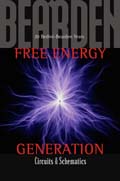This is an ad hoc list of physics-violating devices that have achieved sufficient prominence to make it onto the web. Many have associated comment streams where you can read paranoid posts about sinister energy or oil cabals (OK – the oil cabal actually exists and even has its own web site) suppressing inventions that would free the world from the tyranny of energy scarcity. In fact, the DARPA site for Breakthrough Propulsion Physics even includes a Cautionary Note:
“On a topic this visionary and whose implications are profound, there is a risk of encountering, premature conclusions in the literature, driven by overzealous enthusiasts as well as pedantic pessimists … Avoid works with broad-sweeping and unsubstantiated claims, either supportive or dismissive.”
Wikipedia has a short historical introduction to perpetual motion devices. I have included only a few examples here, mostly just for fun.

Eric Krieg has an extensive list of perpetual motion machines, but seems to have abandoned his compilation around 2003 after some hundred entries. Krieg seems to conclude that most of these devices’ “inventors” were nothing more than scam artists trying to bilk investors out of their money. Luckily, my students understand conservation of energy and won’t be so easily parted from their lucre. On a personal note: I had hoped the inventors were merely optimistic, or perhaps insane; apparently I’m naive.
Frustration with the whack-a-mole quality of these schemes is not new. As far back as 1775, the French Academy of Sciences proclaimed that it would no longer consider any purported perpetual motion devices, because
“This sort of research . . . has ruined more than one family, and in many cases mechanics who might have rendered great services have consumed their fortune, their time, and their genius on it.”
Back then, perpetual motion machines were all mechanical, like the folding wheel (see figure). Nowadays most – but not all – perpetual motion machines are electric or magnetic.
Please note that perpetual motion is possible, if you eliminate friction (for mechanical systems) or resistance (for electrical systems). We know of exotic materials that are (under appropriate conditions) superfluids or superconductors: these will sustain flow or current forever with no loss. However, these systems still do not produce any excess energy, and any energy extracted from them directly diminishes the amount remaining.
Energy for nothing

Interestingly, proponents of these devices split into two camps: those who admit that they violate the known laws of physics, and those who claim to use only standard physical principles. The former seem to revel in rebutting conventional science, while the latter portray themselves as clever engineers who merely exploit obscure loopholes in “normal” science.
-
A clearing house for schemes that promise to produce more energy than they consume. These are apparently called over unity devices. Also weirder stuff that seems to veer toward UFOlogy.
- Orbo: some kind of rotary mechanical / electromagnetic device. Proof that a nicely designed website doesn’t make something true. I’d like to give Steorn (the company responsible for this device) credit for submitting the Orbo for review by a nonpartisan jury, but a few months after jury concluded that the device “[has] not shown the production of energy“, Steorn claimed to have “resolved the key technical problems” and plans to market the Orbo in the near future.
- Motionless Electrical Generator. Some kind of zero-point energy device (extracting energy from the vacuum). Proof that acceptance by the U.S. Patent Office doesn’t make something true. Bonus: the same guy who invented the MEG can also cure cancer.
- Lutec Electricity Amplifier: some kind of coupled AC/DC motor. Proof that acceptance by lots and lots of patent officesdoesn’t make something true.
- Cold fusion: the claim that catalysts can cause deuterium fusion at normal temperatures and pressures. This is a completely different category of unconventional energy generation, since there is no fundamental physics reason why cold fusion cannot exist. Fusion certainly happens in the Sun and in the lab (in tokamaks), though at very high temperatures and pressures, and it certainly liberates large amounts of energy. Fusion may well also occur at STP, but under normal conditions the rate of cold fusion is negligibly small, and it’s hard to see why a catalyst or electric current would increase that rate. Most physicists would love cold fusion to be real; unfortunately, it appears that it’s not.
- Hydrino power. Blacklight Power claims to have discovered a state of molecular hydrogen that has a lower ground state than the one we learn about in physics or chemistry: the hydrino. They have a simple, highly exothermic chemical reaction that produces hyrinos. This doesn’t violate any laws of thermodynamics – if the hydrino exists, it would be possible to build reactors that produce lots of cheap energy – but the hydrino is not an allowed solution to the laws of quantum mechanics as they are currently understood. Blacklight Power has a rebuttal for that, of course. Bonus: the company is located just down the road from my hometown of Princeton, NJ.
- Too-simple ways to increase your car’s mpg:
- Magnetic treatment of gasoline. Not a perpetual motion device, but claims to improve fuel efficiency (and reduce carbon buildup and improve cooling system performance). Apparently magnetism is so mysterious that people are willing to believe it can do just about anything.
- Plug-in mileage enhancer. Insert in cigarette lighter and it increases fuel efficiency up to 30 percent, increases torque, and reduces emissions. Bonus: improves car audio quality, too!
Momentum for nothing

- DARPA’s now-defunct “Breakthrough Propulsion Physics” Program reads like something out of The X-Files. DARPA’s official technical site is rather heavy; the layperson’s summary is more accessible but light on the science; Wikipedia does a pretty good synopsis. Bear in mind that DARPA attempts a lot of really weird stuff that never pans out so the fact that it launched a program like this should not be taken as U.S. government endorsement of any of the physics therein.
- The Dean Drive looks like it falls under the DARPA category of “Oscillation Thrusters” characterized as “Non-Viable“.
- EM-drive. Radiation pressure within a closed, tapered cavity supposedly causes the cavity to accelerate.





